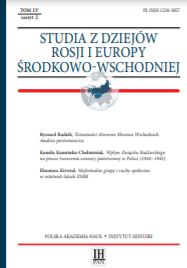Tożsamości zbiorowe Słowian Wschodnich. Analiza porównawcza
Collective Identities of East Slavs: A Comparative Analysis
Author(s): Ryszard RadzikSubject(s): Regional Geography, Recent History (1900 till today), Cultural Anthropology / Ethnology, Identity of Collectives
Published by: Instytut Historii im. Tadeusza Manteuffla Polskiej Akademii Nauk
Keywords: identities of Russians; Ukrainians and Belarusians; threefold nation of Rus’; Soviet identity; national communities of East Slavs;
Summary/Abstract: This article offers a discussion on three types of identity which unite East Slavic societies - Russians, Ukrainians, and Belarusians - or, conversely, separate them from one another. The first is the so-called threefold nation of Rus’, an idea formulated in the second half of the nineteenth century (the term is used only sporadically today), which unites the three communities based on cultural Rus’ness, with Orthodoxy as the vital element which binds them into what Russians view as a nation or a nation-type community. The last few years have seen a process of its disintegration in Ukraine. The second type is Soviet identity, whose traces are still clearly seen. It is a conglomerate of values, attitudes, modes of perception of reality and responses of individuals and social groups to external circumstances which developed under the new order brought about by the Bolshevik revolution. Both these types of identity hamper social emancipation of Ukrainians and Belarusians in various dimensions (also national). The third type is national identity - it is growing stronger in Ukraine, mainly since the Maidan Revolution of 2014, and it is much weaker in Belarus. Its consolidation in both countries increasingly separates their societies from Russia; the process is opposed by Moscow and leads to conflicts (the Crimea, the Donbas). Russians, in turn, are torn between a traditionally perceived imperial community, the threefold nation of Rus’, on the one hand, and the idea of a political or a cultural nation of a Western-type on the other. All three types of collective identity overlap in different confi gurations and with a different level of intensity
Journal: Studia z Dziejów Rosji i Europy Środkowo-Wschodniej
- Issue Year: 55/2020
- Issue No: 2
- Page Range: 179-208
- Page Count: 30
- Language: Polish

